How often to water Christmas cactus is one of the most common questions plant owners have, and the answer is surprisingly simple once you understand how this plant behaves. A Christmas cactus doesn’t follow a strict schedule.
The truth is simple: you should only water a Christmas cactus when the top portion of the soil begins to dry out, usually every 1-3 weeks, depending on the season.
But that’s just the quick answer. What really keeps a Christmas cactus healthy, long-lived, and full of blooms is understanding why its watering needs change throughout the year, how to avoid watering mistakes, and which techniques help the plant thrive without guesswork.
What Makes Watering a Christmas Cactus Different
Unlike typical desert cacti, the Christmas cactus is a tropical forest plant, native to the humid, shaded woodlands of Brazil. There, it clings to trees and rocks, receiving moisture from rain, fog, and humidity, but never sitting in heavy, soggy soil.
That combination, liking moisture but not waterlogging, is where most people get confused.
Water too often, and the plant’s delicate, shallow roots rot quickly. Water too little, and the segmented stems shrivel and fail to bloom. Add seasonal changes, indoor heating, and different pot types, and you can see why watering becomes a bit of a balancing act.
How Often to Water Christmas Cactus (By Season)
Spring – Active Growth Begins
Water every 1-2 weeks.
In spring, the Christmas cactus wakes up from its winter rest. New segments begin forming, which means the plant needs slightly more consistent moisture.
Signs it’s time to water:
- The top inch of soil is dry.
- The pot feels lighter when lifted.
- Segments look a little less plump.
Spring conditions can vary depending on your indoor climate. If your home is still dry due to heating, your plant may need water more frequently. If humidity is naturally higher, it will dry out more slowly.
Summer – Peak Growth Season
Water every 1 week (sometimes every 5-7 days in hot weather).
Summer is the most intensive growth period. Longer days and warmer temperatures cause soil to dry faster. Your cactus will be actively producing new pads and storing energy for fall budding.
During summer:
- Check the soil twice per week.
- Water deeply whenever the top 1-2 inches feel dry.
- Increase humidity if your environment is very hot.
Just remember: never water on a fixed schedule. Always check the soil first.
Fall – Preparing for Bloom
Water every 2-3 weeks.
Fall is the “pre-bloom” season. This is when the Christmas cactus starts setting buds, and ironically, it prefers less frequent watering during this time. If you keep the soil constantly damp, the plant may drop buds before they develop.
Reduce watering by allowing the soil to dry out more between waterings, but don’t let it become bone dry.
If your plant is in a cool room (60-70°F / 15-21°C), it will need even less water.
Winter – During and After Bloom
Water every 2-3 weeks.
Winter watering depends on two things:
- Whether the plant is blooming
- Your home’s heating and humidity levels
During the bloom cycle, the plant needs slightly more moisture but not as much as in summer. Water when the top inch of soil feels dry.
After blooming ends, the plant enters a short rest period and needs much less water. Let the soil dry out almost completely before watering again.
Signs of Overwatering
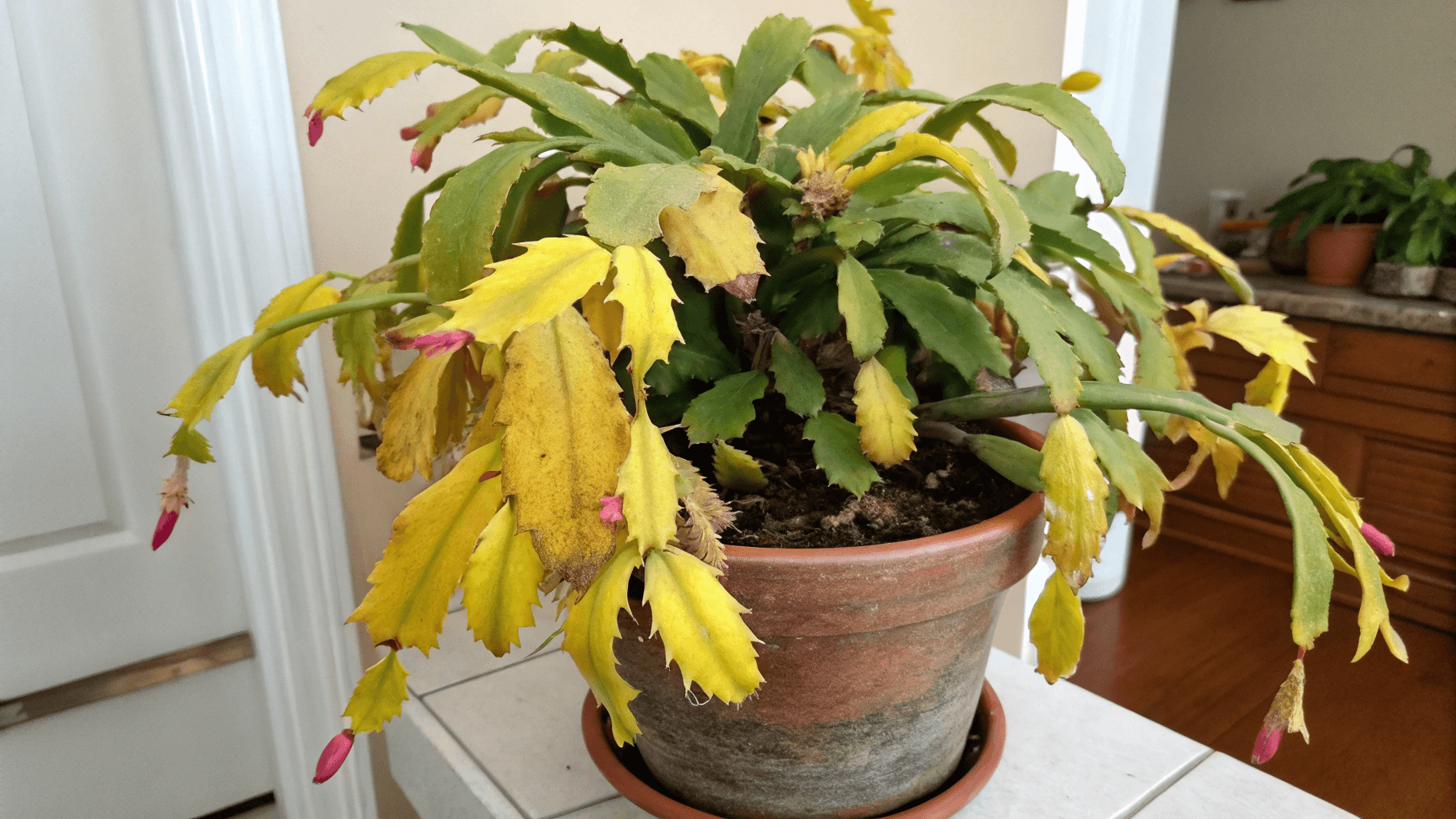
Overwatering is the most common mistake with Christmas cactus care. Because the plant likes humidity, many people assume it likes frequent watering, but that’s not the case.
1. Soft, Mushy Stem Segments: When the stems feel limp or mushy instead of firm, the roots are likely waterlogged.
2. Yellowing Leaves: Yellow, pale segments indicate poor oxygen flow to the roots due to soggy soil.
3. Foul or Sour Soil Smell: A sour odor means root rot has already started.
4. Browning at the Base: Brown, mushy spots where the segments meet the soil are a major warning sign.
5. Potting mix stays wet for more than 7–10 days
Slow-drying soil almost always means:
- the pot is too large
- the soil is too dense
- or you’re watering too frequently
If you see these signs, stop watering immediately and allow the soil to dry out. In severe cases, repot into a fresh, well-draining mix.
Signs of Underwatering
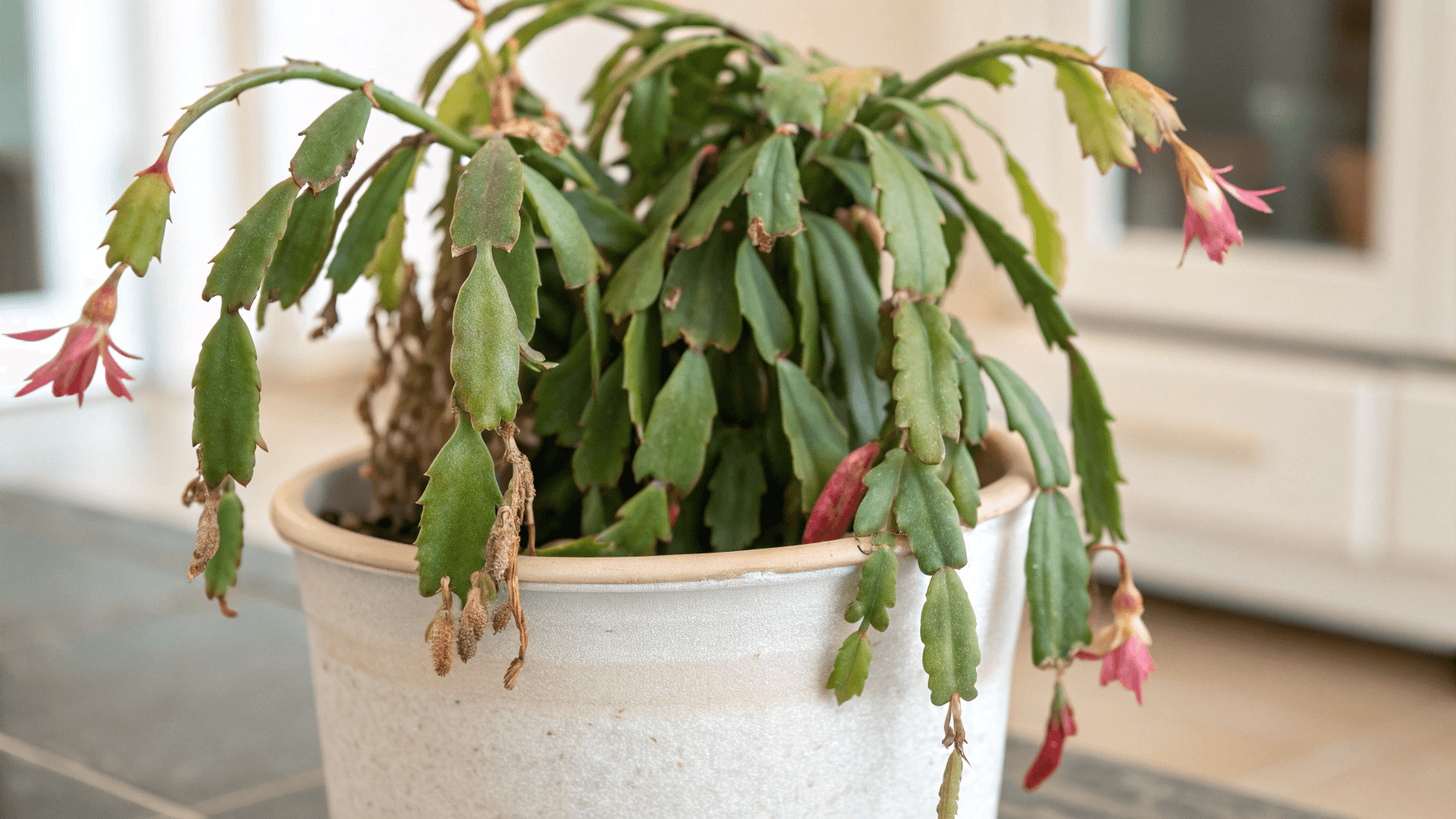
Although overwatering is more dangerous, underwatering can cause long-term stress.
1. Wrinkled or Shriveled Segments: The stems may look deflated, like folded or wrinkled fabric.
2. Segment Tips Curling: A clear sign the plant is dehydrated.
3. Slow or Stunted Growth: If the plant hasn’t added new segments in months, a lack of moisture may be part of the problem.
4. Bud Drop (During Fall/Winter): If the plant forms buds but drops them before blooming, underwatering is a likely reason.
Thankfully, underwatering is easy to fix, just give the plant a slow, deep watering and it often perks up within a day or two.
The Best Watering Methods for a Christmas Cactus
The way you water is just as important as how often.
1. The Soak-and-Drain Method

This is the most reliable technique.
- Take the plant to a sink.
- Water thoroughly until water runs out of the drainage holes.
- Let the pot drain completely.
- Return it to its saucer, but dump any water that collects underneath.
This method ensures the entire root system receives moisture without sitting in water.
2. Bottom Watering (Optional)
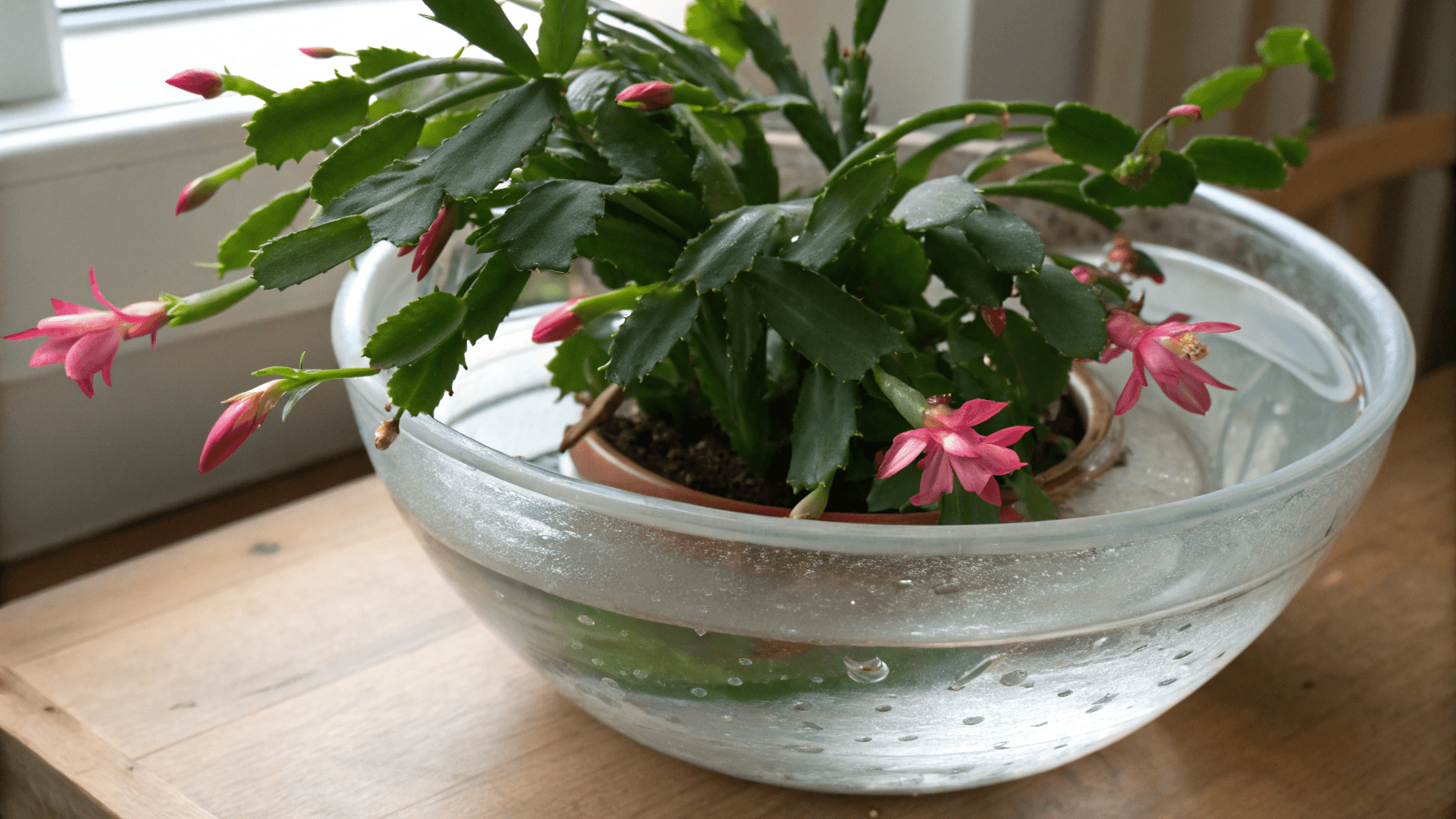
Bottom watering can be useful if your soil dries very quickly or you tend to underwater, but it shouldn’t be your only method. If used exclusively, salts may build up in the soil.
Use bottom watering once in a while to ensure deeper hydration, but flush from the top regularly.
Avoid Light Sprinkling
A small amount of water on top does not hydrate the root system and can cause uneven moisture levels.
For best results, water deeply but less often.
Best Type of Water for Christmas Cactus (Rainwater, Tap, Distilled)
Christmas cactus is surprisingly sensitive to water quality, especially if your tap water contains additives.
- Rainwater (Best Choice)
Rainwater most closely matches what the plant receives in nature. It’s soft, slightly acidic, and free of chemicals.
- Distilled or Filtered Water (Excellent Alternative)
These options help prevent:
- mineral buildup,
- leaf spotting,
- and salt accumulation.
- Tap Water (Usually Fine, With One Exception)
Most tap water is acceptable if:
- you let it sit for 24 hours before watering (to let chlorine dissipate)
- you avoid hard water high in minerals
If your tap water leaves white residue on pots or faucets, your plant may eventually suffer from salt accumulation. In that case, switch to rainwater or filtered water.
Pot Types That Help Regulate Water
The pot you choose can make watering easier or create problems.
- Terracotta Pots (Best for Beginners)
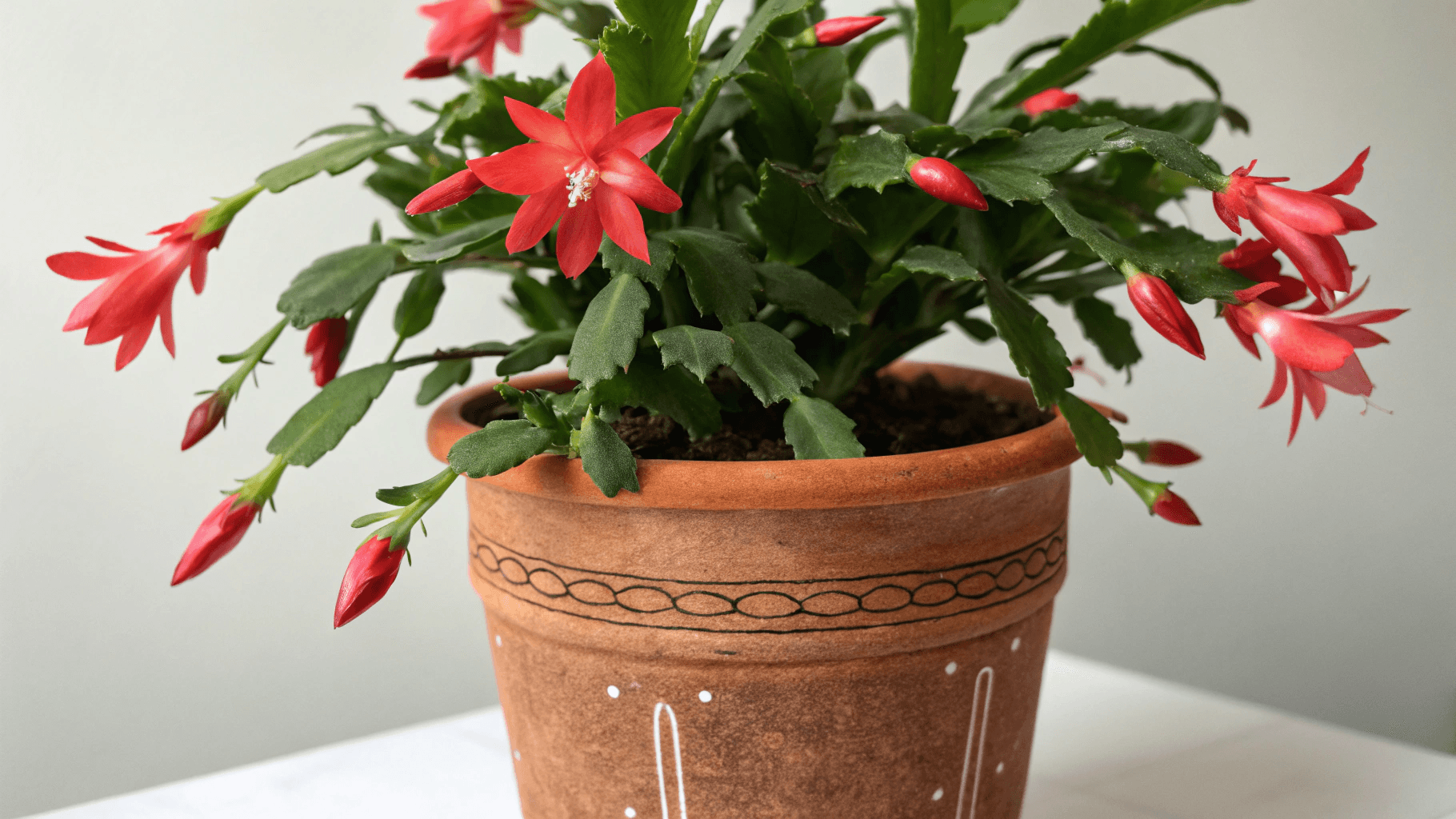
Terracotta naturally breathes and helps moisture evaporate, reducing the chance of root rot.
Pros:
- Helps soil dry evenly.
- Ideal for people who tend to overwater.
- Prevents soggy roots.
Cons:
- Soil dries faster, so you must check more often.
- Plastic Pots (Better for Dry Homes)

Plastic holds moisture longer, which can be helpful if:
- Home is warm
- Air is dry
- Forget to water
Pros:
- More consistent moisture.
- Lightweight and inexpensive.
Cons:
- Can easily lead to overwatering if you’re not careful.
- Needs a very well-draining soil mix.
Why Your Pot Needs Drainage Holes
No pot, terracotta or plastic will save your plant from waterlogging if excess water can’t drain out.
If your pot does not have drainage holes, the root system will eventually rot, no matter how careful you are with watering.
Conclusion
Watering a Christmas cactus doesn’t need to be complicated, just follow the plant’s natural rhythms. Water only when the top inch of soil is dry, adjust seasonally, and use the soak-and-drain method for even hydration. Pay attention to the signs of over- or underwatering, choose a pot that matches your watering habits, and use clean water whenever possible.
With these simple steps, your Christmas cactus will reward you with vibrant growth and beautiful blooms year after year.

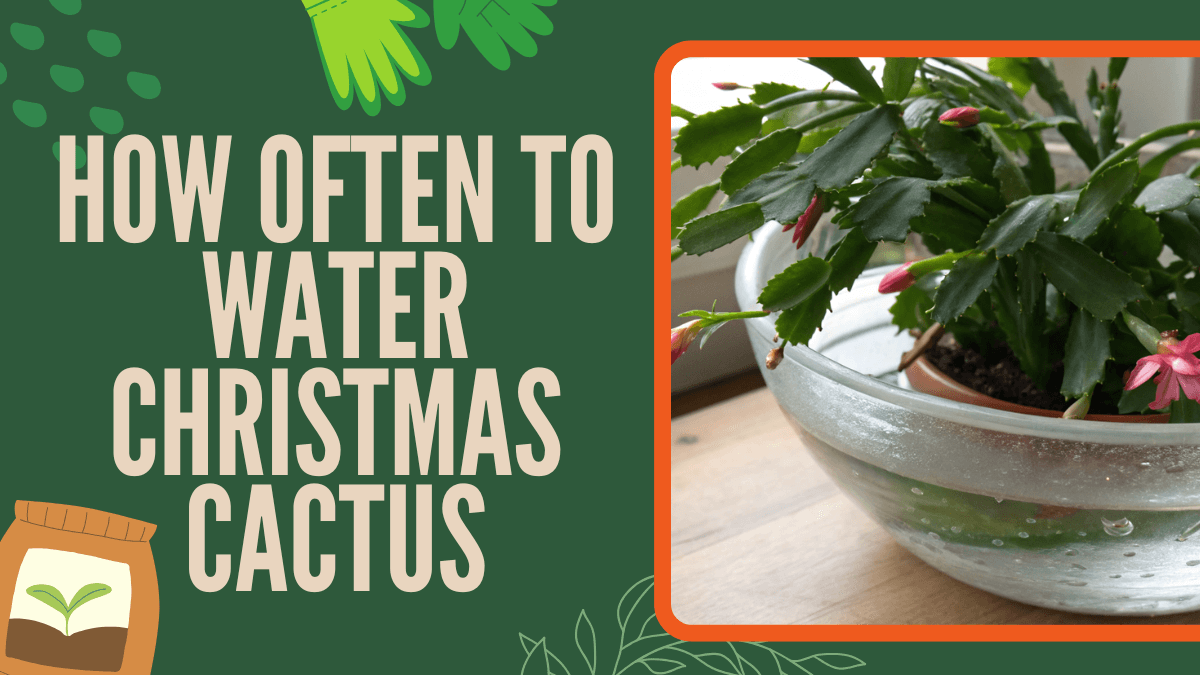
 ChatGPT
ChatGPT
 Perplexity
Perplexity
 Claude
Claude

Leave a Reply